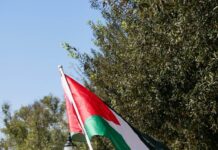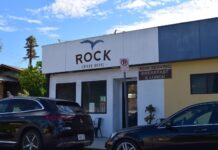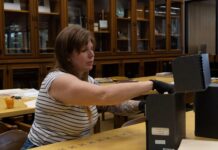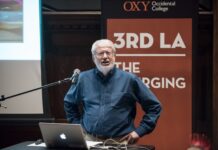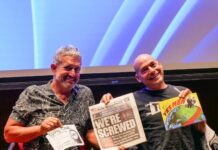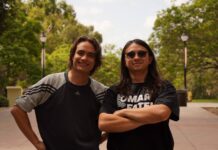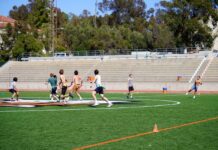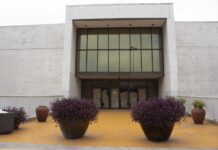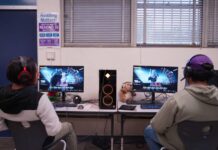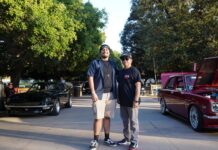Author: Thomas Schryver
Pocketed between the steep green foothills of Forest Lawn Memorial Park, Interstate Route 2 and North San Fernando Road, lies “Area One” of the Glassell Park community. Billboard advertisements for the memorial park grounds show an elderly Caucasian couple holding each other by the ocean with a look of happiness and tranquility on their faces, with a caption that reads “Understanding.” The nearby Van de Kamps Factory, which once was the called the “Taj Mahal of all bakeries,” is boarded up and closed down between Fletcher Drive and the Freeway.
Pocketed between the steep green foothills of Forest Lawn Memorial Park, Interstate Route 2 and North San Fernando Road, lies “Area One” of the Glassell Park community. Billboard advertisements for the memorial park grounds show an elderly Caucasian couple holding each other by the ocean with a look of happiness and tranquility on their faces, with a caption that reads “Understanding.” The nearby Van de Kamps Factory, which once was the called the “Taj Mahal of all bakeries,” is boarded up and closed down between Fletcher Drive and the Freeway.Just over two miles away from Occidental College sits the intersection of Drew Street and Estara Avenue, which, for over fifteen years, has been called one of the most dangerous areas of Los Angeles. Ironically, the very problem area that has been the Drew Estara neighborhood is less than one mile away from the Northeast Los Angeles Police Department (L.A.P.D.) station.
Pocketed between the steep green foothills of Forest Lawn Memorial Park, Interstate Route 2 and North San Fernando Road, lies “Area One” of the Glassell Park community. Billboard advertisements for the memorial park grounds show an elderly Caucasian couple holding each other by the ocean with a look of happiness and tranquility on their faces, with a caption that reads “Understanding.” The nearby Van de Kamps Factory, which once was the called the “Taj Mahal of all bakeries,” is boarded up and closed down between Fletcher Drive and the Freeway.
Formed in the 1940s, L.A. gang The Avenues has long been a threat to Northeast L.A. As a branch of the Mexican Mafia, which has several divisions, The Avenues is the most powerful of the groups and calls Drew and Estara its home turf. “The Avenues have been ranked as fourth out of the top five most dangerous gangs in Los Angeles,” President of the City Council, District 13 representative, and former Oxy Professor Eric Garcetti said.
Murder, hate crimes, robbery, narcotics trafficking, intimidation, racketeering, illegal immigrant smuggling, and vandalism are just some of the charges Avenues gang members have been convicted of over the years.
The very terrain of the Drew Estara neighborhood has contributed to the danger it has posed to police as well as the substantial difficulty law enforcement has had in this area. Drew Street runs straight for almost half a mile, increasing in elevation from its dead-end on the west side of the neighborhood until it hits Weldon Road. Only two streets intersect it, and the combination of its steep incline makes it easy to spot approaching police cars.
Its position next to Forest Lawn Memorial also gives gang members easy access to a hiding spot. “Gang members would park cars next to the walls of Forest Lawn Memorial Park so they could jump up on the hoods and hop over the fences if they had to run from cops,” Captain Murphy of the Northeast division of the L.A.P.D. said.
At the head of the gang lies the quite literal matriarch, Maria “Chata” Leon. Maria, an illegal immigrant from the town of Tlalchapa, Mexico, arrived in the Drew Estara neighborhood in the mid-eighties when she was in her early twenties. Over the next two decades, she gave birth to thirteen different children from five different fathers, almost all of whom were upper echelon gang members and drug dealers.
Most of Maria’s boys grew up to be drug dealers themselves, the most notorious of whom went by the surnames of Real, Leon, and Martinez. Brothers Francisco and Nicolas Real, Danny and Jose Leon, and Randy and Jesus Martinez are all high-ranking members of the Avenues gang.
Maria has been arrested on at least 14 separate occasions since her arrival to Drew Street in 1985, according to the L.A. Times. “Maria has also been deported several times,” Murphy said. “She was arrested here this past summer.”
Murphy was unaware of Maria’s current whereabouts, although she is last known to have purchased a home in Victorville, California, about 80 miles northeast of Los Angeles, which has now been confiscated by the IRS.
The Leon family’s former residence at 3304 Drew Street, referred to as “Satellite House” for the large black satellite dish on its roof, became the epicenter of Drew Street’s fear and violence.
Past searches of the Leon family home have turned up explosives, automatics weapons, surveillance cameras, and even a laser tripwire system. Under the same roof as this veritable armory were living six children under the age of ten, including Maria’s then three-month-old boy. A “shrine” to the early twentieth century folkloric figure, Jesus Malverde, known as the “patron-saint” of drug traffickers, was also discovered in the Satellite House.
The Weekly spoke to Neighborhood Watch member and current representative of the Drew Estara area Bradley (who declined to provide his full named), who spoke of the crime and violence his neighborhood has been afflicted with, as well as the necessity of a secure relationship between the city and the Drew Estara neighborhood. “There has been disenfranchisement and disarray with the constituents of this neighborhood,” Bradley said. The Drew Estara Neighborhood Watch, which consists of thirty to forty participants, “helps bridge the gap between the L.A.P.D. and the community.” Neighborhood Watches like the Drew Estara one exist all over Los Angeles, predominantly in lower-income areas.
“Area One is still at the tithers of council district Thirteen,” Bradley said, “so we end up being less of a concern.”Driving down Drew Street, Bradley pointed towards the jam-packed residences that lined the road. “Looking at these apartment buildings from the street, it looks like they might house maybe forty or fifty tenants,” Bradley said. “But what you can’t see is that these buildings extend far back beyond your visibility in the street, and house hundreds of more tenants in these areas.”
“One of the biggest problems the Drew Estara neighborhood has had in the past is that of absentee landlords,” Bradley said, further describing absentee landlords as property owners who have a largely hands-off approach to running the apartments they manage. “There are no onsite managers; the owners are not really there at all. They don’t even clean or keep up maintenance in these buildings. They’re just there to collect the rent.”
It is this problem of absentee landlordism compounded with over-population, Bradley explained, that has made it easy for criminals, drug dealers, and gangsters to find housing. “There’s no monitoring of the buildings on a regular basis and no screening of tenants, so you don’t know what kinds of tenants are living there.” “Some of these landlords are wealthy people from Newport Beach who just own property,” Murphy said.Bradley emphasized the notion that if these landlords were actually connected with and in-tune with the community in which their property stood, there could be a drastic reduction of the neighborhood’s criminal activity. “Landlords have to be aggressive with [keeping tabs on their residents],” Bradley said.
To the potential credit of some of these under-performing landlords, Murphy spoke of the understandable fear that property owners would feel when speaking to dangerous tenants about policy and violation code issues. Christine Pelisek of the L.A. Weekly quoted apartment owner Eduardo Garcia as saying, “I had to paint the back of my building four times in the last year and a half [because of graffiti] . . . I can’t have managers do it because [local thugs] will threat
en him and tell him they will kill him.”
Local KCAL 9 CBS News footage of Drew Street on the day of the raids also showed an apartment with a “For Rent” sign that, at the bottom, read “NO SNITCHES.”
Although the Avenues had been a source of turmoil in the Glassell Park community, one event helped propel recent L.A.P.D. intervention. In the afternoon of February, 2008, 22-year-old Drew Street gang member Danny “Klever” Ivan Leon drove down to Cypress Park, home to a rival gang of The Avenues. Near Aragon Elementary School, 36-year-old Marcos Salas walked while holding the hand of his two-year-old granddaughter. As Leon’s White Nissan sedan passed Marcos, the passengers of the car opened fire, wounding Salas who later died of his injuries. Miraculously, Salas’ granddaughter escaped the barrage of bullets unharmed.
As Leon and his fellow Avenidas fled the scene of the crime back to Drew Estara, an unmarked car containing an L.A.P.D. Criminal Apprehension Team who had been alerted of the shooting, tailed the gangsters.
When Leon and his passengers spotted the C.A.T. car following them, the Avenues members pulled over. Donned in a ski mask, Leon pulled out an AK-47 and opened fire on the police. A shootout between The Avenues gangsters and the police ensued, shutting down the area for dozens of blocks, and resulted in the death of Leon. Leon’s accompanying gang members, Guillermo Ocampo and Jose Angel Gomez were immediately apprehended by the police, and driver Rafael Carrillo, who had fled the scene, was found and arrested four days later.
Danny was the half-brother of Francisco “Pancho” Real, another son of Maria Leon, and an active Avenues member who had allegedly been given control of the Drew Estara area by the Mexican Mafia. According to the LA Weekly, L.A.P.D. wire taps on Francisco telling of his half-brothers death led him to conclude, “Shit happens.”
The Drew Street shootout with Danny Leon wasn’t the sole tipping point that incited further L.A.P.D. presence in the Drew Street area. In the Fall of 2007, the Northeast division of the L.A.P.D. went to the Federal Government for assistance.”Drew Street was the worst area we had,” Murphy said. “Our narcotics units were in there all the time. In order to really stop it, we needed to go in there with the Feds.”
With federal cooperation, a task force was formed against the Drew Street clique. Police used wire taps on known gang members and put cameras on their homes. “We worked the wire for five to six months,” Murphy said.
With a 120-page, 88-count federal indictment formed against the Drew Street clique and Federal cooperation, law enforcement agents were finally prepared to strike.
At 4:00 AM on June 25th, 2008, a staggering 500 officers, including SWAT members, Northeast L.A.P.D., Glendale P.D., and federal agents were deployed at Drew and Estara.Armed with SWAT gear and flashbang grenades, the men and women of the law enforcement entered the neighborhood and apprehended their suspects.
“It was the largest raid in L.A.P.D. history,” Murphy said.Twenty-five search warrants were served, twenty-eight firearms recovered, and Maria’s second home in Victorville was said to have been recovered. “There were 70 targets for witness intimidation, narco-trafficking, racketeering, murder, and attempted murder” Murphy said. “We have 66 out of those 70 targets to date.” Miraculously, not one law enforcement agent, gang member, or civilian was injured.
Murphy also explained the advantages of Federal indictments over State indictments. “With a federal charge, you have to do at least 85 percent of your time [that you are sentenced to].” Another advantage is that you’re going to do your time potentially 3,000 miles away, in federal prisons in places like Connecticut.”
Incarcerating the convicted criminals in such isolated locations, Murphy said, went a long way to removing their contacts to their gang affiliates. “The Mexican Mafia has a very large presence in prisons in California and Texas, but elsewhere in the United States, they’re hardly a factor.”
“Each of these characters is not going to be lounging around in a county or state prison” emphasized L.A.P.D. Chief William Bratton in a press conference. “Some of these characters better put on their long underwear,” he said, “because they’re going to be spending winters in Maine somewhere.”
U.S. Attorney for the Central District of California Tom O’Brien spoke to members of the community at the Glassell Park Senior Center following the raid. “We’re not done,” O’Brien said. “I’m not turning my back on this community; I never will, and I certainly wont turn my back on this particular part of the community.”
“We have chopped the head off a gang today, but they’re chickens,” Garcetti told the Glassell Park resident. “We’re going to be chasing that headless body for some time.”
“We initially used a three-pronged approach in our efforts in Drew Street” Murphy said. “First, we had the SWAT officer strike on June 25th. Second, we deployed a mobile command center and foot patrol twenty hours a day, seven days a week for the whole summer. Third, we worked on providing services for the Drew Estara community.” The community is responding incredibly well to the improvement efforts.
These city-funded services included civic injunctions against the landlords who had not been keeping tabs on their tenants or property. These injunctions would actually have forced the landlords to live on the very street premises that they owned and most likely feared because of violence and crime.
In a press conference shortly after the Drew Street police raid, L.A. city attorney Rocky Delgadillo said that if their managerial methods did not improve, the city would force the absentee landlords to “experience that same misery that the people of this neighborhood have had to deal with for so long.”
The city also provided graffiti and street clean-up services, job and college fairs, and worked on cultivating a sense of trust and familiarity between patrolling police officers and Drew Estara residents.
“We talked with residents on how to build up [their] resumes, picked up the trash, and sprayed down the neighborhood,” Murphy said. Grassroots movements like this have a history of success in poorer neighborhoods.Quoting famous Father Greg Boyle, Garcetti commented, “Nothing stops a bullet like a job.” Obviously, if the economic state of the neighborhood improved, then the violence might subside.
Murphy was particularly proud of the effect the city’s efforts have had on the youth of the Drew Estara neighborhood. He recounted how teachers at nearby schools such as Fletcher Elementary and Irving Middle school had described some of their students before this school year as tired and falling asleep in class after being up all night hearing gun shots. Now, these same children have demonstrated a vast improvement. “The kids showed an incredible positive change come September ’08,” Murphy said.
Parents, too, have been responding to the city’s increased outreach to the neighborhood. “At parents night seminars for our local schools in the past, we’d usually get about 150 parents who would show,” Murphy said. “Now we had over 400 parents show up. We took this as an incredible symbol of change.”
Murphy remarked that L.A.P.D. relations with local youth weren’t perfect, as police had arrested some of the children’s own family members. Murphy said the L.A.P.D. “adopted” Fletcher elementary, giving them presents for Christmas and working with clergymen to improve relationships.
In spite of the police work done in the Drew Estara neighborhood, some residents remain discontent when they compare the police force’s work in fighting existing crime with its disproportionately small efforts to prevent crime from occurring. The issue of preventative efforts being eschewed for suppression tactics has gone unnoticed by neither Glassell Park’s residents nor by its representatives. In response to Northeast L.A.’s Arroyo Seco Journal article on the Drew Street arrest, one
commenter wrote, “Man, they can bring all of that to bear on a lousy street gang-but what are they doing to help the future members of the Avenues [in] doing something else with their life? This is just more meat for the grinder-more jobs for cops, more jobs for prison guards, more money for prisons.”
Garcetti, too, spoke to the Weekly about the necessity of more preventative solutions: “We’re spending less than one percent on prevention and way too much on suppression. To prevent gang violence, you have to start really early. For kids growing up and seeing drug deals everyday, what kind of example does that set? What inspiration does that provide? We need a criminal justice system that shows a pathway out.”
For now, the work that the residents, police, and city have done have led to unmistakably beneficial changes in Glassell Park’s area one. L.A.P.D. statistics show a tremendous decrease in violent crimes today as opposed to the mid-nineties, with 100 violent crimes in Drew Street and surrounding neighborhoods and 26 violent crime since the year 2006. “We have the lowest crime rate in 50 years,” wrote Eric Garcetti on his official home page
“We changed the community’s perception. It was one of our worst neighborhoods,” Murphy said of the neighborhood that has been called “el barrio bajo.”
“It’s not perfect,” both Murphy and Garcetti concede, but both city and community efforts appear to be headed in a positive direction.
As of February 2009, Drew Street’s Satellite House has now been demolished by the city; an empty lot now lies in place of the compound that once stood as a stronghold of drug, weaponry and intimidation.
People walk down the street with their dogs, and children wander out into street to play. Murphy marveled at the progress Drew Street has made in the past year alone. “We were conducting a standard use-of-force review with the review board following the raid,” Murphy said. “There was a guy in a business suit inquiring about speed bumps and parking policies . . . years ago a guy like that would have been shot and robbed in that neighborhood.”
“This was the forgotten area; this was the dead-end because no one really cared,” Bradley said. “We know this community has hope.”
This article has been archived, for more requests please contact us via the support system.
![]()


